For the 2025 school year, there are 2 public charter schools serving 534 students in Acorn Montessori Charter School (79437) School District. This district's average charter testing ranking is 4/10, which is in the bottom 50% of public charter schools in Arizona.
Public Charter Schools in Acorn Montessori Charter School (79437) School District have an average math proficiency score of 25% (versus the Arizona public charter school average of 40%), and reading proficiency score of 31% (versus the 47% statewide average).
Minority enrollment is 42% of the student body (majority Hispanic), which is less than the Arizona public charter school average of 64% (majority Hispanic).
Overview
This School District
This State (AZ)
# Schools
2 Schools
575 Schools
# Students
534 Students
229,330 Students
# Teachers
n/a
14 Teachers
Student : Teacher Ratio
n/a
n/a
District Rank
Acorn Montessori Charter School (79437) School District, which is ranked within the bottom 50% of all 607 school districts in Arizona (based off of combined math and reading proficiency testing data) for the 2021-2022 school year.
Overall District Rank
#383 out of 631 school districts
(Bottom 50%)
(Bottom 50%)
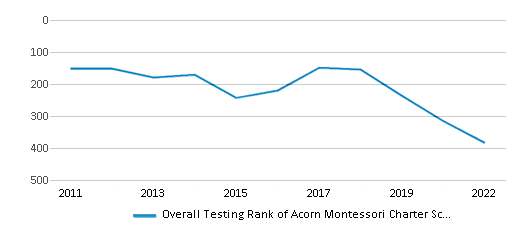
Math Test Scores (% Proficient)
24%
35%
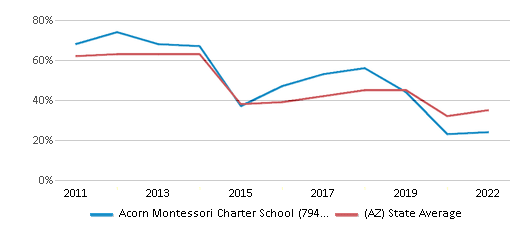
Reading/Language Arts Test Scores (% Proficient)
31%
40%
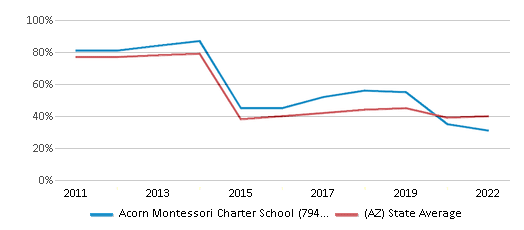
Science Test Scores (% Proficient)
20-24%
24%
Students by Ethnicity:
Diversity Score
0.53
0.68
# American Indian Students
12 Students
4,750 Students
% American Indian Students
2%
2%
# Asian Students
1 Student
13,867 Students
% Asian Students
n/a
6%
# Hispanic Students
197 Students
99,415 Students
% Hispanic Students
37%
44%
# Black Students
6 Students
15,913 Students
% Black Students
1%
7%
# White Students
311 Students
83,359 Students
% White Students
58%
36%
# Hawaiian Students
n/a
801 Students
% Hawaiian Students
n/a
n/a
# Two or more races Students
7 Students
11,192 Students
% of Two or more races Students
2%
5%
Students by Grade:
# Students in PK Grade:
-
-
# Students in K Grade:
68
17,628
# Students in 1st Grade:
69
18,620
# Students in 2nd Grade:
56
18,750
# Students in 3rd Grade:
63
18,486
# Students in 4th Grade:
60
18,571
# Students in 5th Grade:
62
18,296
# Students in 6th Grade:
59
18,600
# Students in 7th Grade:
54
18,139
# Students in 8th Grade:
43
17,892
# Students in 9th Grade:
-
12,590
# Students in 10th Grade:
-
13,786
# Students in 11th Grade:
-
14,849
# Students in 12th Grade:
-
23,123
# Ungraded Students:
-
-
District Revenue and Spending
The revenue/student of $10,142 in this school district is less than the state median of $11,421. The school district revenue/student has declined by 7% over four school years.
The school district's spending/student of $9,753 is less than the state median of $11,323. The school district spending/student has declined by 7% over four school years.
Total Revenue
$5 MM
$12,837 MM

Spending
$5 MM
$12,727 MM
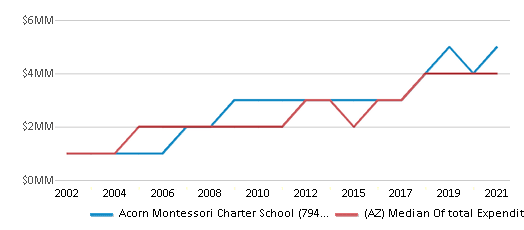
Revenue / Student
$10,142
$11,421

Spending / Student
$9,753
$11,323
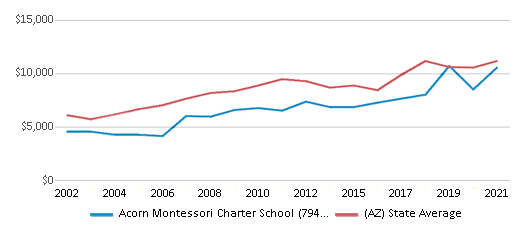
Best Acorn Montessori Charter School (79437) School District Public Charter Schools (2025)
School
(Math and Reading Proficiency)
(Math and Reading Proficiency)
Location
Grades
Students
Rank: #11.
Acorn Montessori Charter School
Charter School
(Math: 25% | Reading: 34%)
Rank:
Rank:
5/
Bottom 50%10
8556 E Loos Dr
Prescott Valley, AZ 86314
(928) 775-0238
Prescott Valley, AZ 86314
(928) 775-0238
Grades: 2-8
| 278 students
Rank: #22.
Acorn Montessori Charter School Inc. - West
Charter School
(Math: 20-29% | Reading: 11-19%)
Rank:
Rank:
3/
Bottom 50%10
7555 E Long Look Dr
Prescott Valley, AZ 86314
(928) 775-0238
Prescott Valley, AZ 86314
(928) 775-0238
Grades: K-3
| 256 students
Recent Articles

Year-Round Or Traditional Schedule?
Which is more appropriate for your child? A year-round attendance schedule or traditional schedule? We look at the pros and cons.

Why You Should Encourage Your Child to Join a Sports Team
Participating in team sports has a great many benefits for children, there is no doubt. In this article you will learn what those benefits are.

White Students are Now the Minority in U.S. Public Schools
Increasing birth rates among immigrant families from Asia and Central and South America, combined with lower birth rates among white families, means that for the first time in history, public school students in the United States are majority-minority. This shift in demographics poses difficulties for schools as they work to accommodate children of varying language abilities and socio-economic backgrounds.





